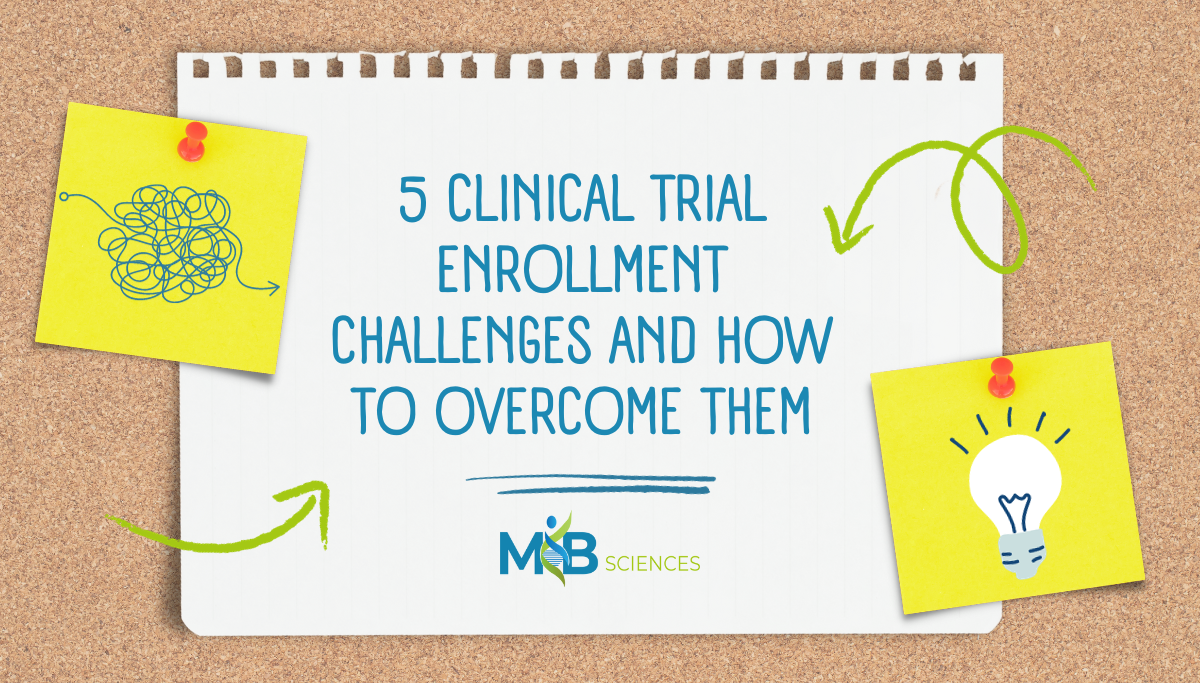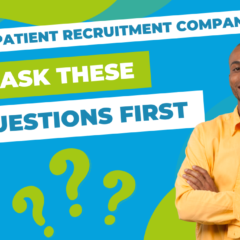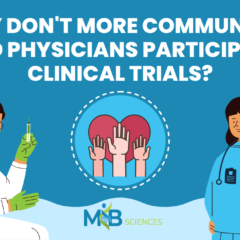5 Clinical Trial Enrollment Challenges And How To Overcome Them
It’s estimated that over 80% of clinical trials experience delays, primarily because they fail to meet patient enrollment targets, according to Clinical Leader.
How can you stop your trial from becoming a statistic?
In this resource, we’ll discuss the most common barriers to enrollment and what clinical trial sponsors, study directors, site managers and others can do to overcome them.
The challenge: Unrealistic enrollment forecasts
Many sites make assumptions about how long it will take to recruit and enroll patients for a particular trial based on previous experience with a similar one.
“Most enrollment projections in a clinical trial are based on best-case scenarios,” said Pratik Kalsaria, a clinical project manager with Med Institute, in an article for life sciences engagement and analytics software Array. “Trial sites tend to over commit and are overly optimistic about their enrollment rates.”
These unrealistic expectations can lead to overconfidence and a lack of contingency planning for clinical trial sponsors.
The solution: Use data to set appropriate enrollment targets
A site feasibility study can help your team determine what is realistic for each clinical trial site as you select them. A few questions to consider:
- How many patients with this condition are treated at this site each month?
- If data exists on previous screenings or an earlier phase of the trial, what percentage of recruited patients passed pre-screening criteria?
- What percentage of recruited patients did the site ultimately enroll?
Visiting the sites and gathering more information about their team and their processes for following up with recruited patients can help increase your confidence in their ability to deliver.
The challenge: Lack of visibility into site performance
The decentralization of many clinical trials makes it difficult to identify challenges such as underperforming sites early in the study. Individual trial sites often use their own electronic data capture systems, making it difficult to receive consistent reporting or identify problems. Sponsors may also be relying on clinical research organizations or another third-party to oversee their trial, limiting visibility. Regulatory requirements may also limit what data can be shared.
The solution: Set clear expectations for sites and monitor results
Engaging with clinical trial sites during site selection and prior to the start of the study can help to set expectations and identify potential obstacles early. Work with sites to determine what metrics they can realistically provide at regular intervals and what format is best. Regular meetings can also be an effective way to check in.
The challenge: Difficulty recruiting qualified patients
Recruiting enough qualified patients is often the most significant hurdle contributing to clinical trial delays. These challenges occur for several reasons.
Many patients simply aren’t aware of their options for participating in trials, or they have misconceptions about what participation entails.
For trials investigating treatments for rare diseases, including genetic or neurological disorders, the patient population is inherently small and can be difficult to find.
New FDA requirements to include Diversity Action Plans in clinical trials can also make recruitment more challenging.
The solution: Hire an experienced patient recruitment firm
The right patient recruitment company can help sponsors and site directors identify patient populations that are representative of the people who will benefit from their drug or device and recruit them in the most efficient, cost-effective manner.
In addition to accelerating the patient enrollment process, they can improve patient engagement and retention so your trial avoids delays due to loss of participant interest. As you research patient recruitment firms, here are a few important questions to consider:
How does the firm identify diverse patient populations?
Do they have access to extensive patient databases or patient registries? Are they reaching out in more personal, proactive ways (such as working with community-based physicians and advocacy groups) in addition to using digital marketing?
What patient recruitment metrics do they measure?
Look for a vendor who is committed to mutually agreed-upon metrics, such as average recruitment rate, the number of patients who meet enrollment criteria, and the actual number of screened or enrolled patients.
What therapeutic expertise do they have?
It’s helpful for a patient recruitment partner to have experience with the condition you are treating or conditions that have similar challenges. For example, if you are looking for help in recruiting for a Parkinson’s clinical trial, a patient recruitment company that has recruited for a condition like ALS would have similar experience in neurodegenerative rare diseases.
What is their patient screening process?
Screening can include patients simply responding to digital ads and filling out a form to digital pre-screening or more advanced phone screening, depending on your trial.
The more experience your recruitment company has with your target patient population, the smoother this process will be.
The challenge: Clinical trial sites are stretched thin
The clinical research workforce is still experiencing the lingering effects of the pandemic, with seven jobs posted for every experienced research coordinator looking for work, according to the Society for Clinical Trials.
They note as many as 95% of cancer centers are experiencing staffing challenges, which can hurt patient recruitment and enrollment.
The solution: Partner with clinical trial staff in a supporting role
Clinical trial sponsors, their vendors, including CROs and recruitment firms, can help alleviate the pressures faced by overburdened clinical trial sites. Here are a few examples:
Using centralized patient communication platforms
Technology can help to streamline communication between clinical research associates, vendors and patients. These systems can automate reminders, follow-ups, and other necessary communications, ensuring patients are well-informed at every step.
Tailor communication to patient preferences
Don’t assume the same communication methods will work for all patients. Some patients rarely check email and prefer to receive updates via texts, phone calls, or mail. Your sites or recruitment partners should maintain updated patient profiles and use this data to reach out to them using their preferred methods, increasing the chances of timely responses.
Provide multilingual support
Given the diverse patient populations involved in trials, offering translation and interpretation can significantly enhance patient engagement.
Have dedicated patient liaisons
Some recruitment firms can provide dedicated personnel whose primary responsibility is patient communication. These individuals can serve as the point of contact for patients, addressing their queries, concerns, and ensuring they’re prepared for every trial-related appointment.
Provide educational materials
Developing and distributing clear, easy-to-understand educational materials can reassure patients who are participating in a trial for the first time and help address common concerns.
Make it easy for patients to provide feedback
Regular feedback can help your clinical trial team identify logistical challenges or potential breakdowns in communication. It can also help you revise your strategies to improve patient engagement in the future.
Engage with local communities
Recruitment firms can engage with local communities where the trial sites are located to build trust and rapport. This can help with recruitment and communication throughout the trial.
Host training and workshops
Sponsors and their vendors can conduct workshops and training sessions for site staff, equipping them with the latest tools, techniques, and best practices in patient communication.
Study design and protocol
Sometimes the barriers are unknowingly built into your clinical trial study design and protocol.
A study in the Journal of the National Cancer Institute found structural and clinical factors are the most common reason why cancer patients don’t participate in trials.
The review of 13 studies involving 8,800 patients found 56% didn’t have a trial available at their institution, while 22% were ineligible due to enrollment criteria. The research also discovered that when patients are offered the opportunity to participate in a clinical trial, they only opt in about half the time. Your initial study design should account for the factors that may impact enrollment, including eligibility and site locations.
If enrollment challenges persist, you may need to re-evaluate the study criteria. Is there unnecessary exclusion criteria that could be modified, such as requiring that trial participants have received a COVID-19 vaccine for a trial unrelated to COVID?
Are you excluding people over a certain age because of concerns about their health throughout the trial? If you are reaching recruitment targets but consistently failing to enroll patients, it may be worth revising your study protocol with regulatory approval.
While protocol modifications are not uncommon, they can cause added costs and further delays while your trial awaits approval. The lost opportunity cost of not having your product on the market for another six months, potentially allowing a competitor to introduce a similar product ahead of yours, is even more significant.
The solution: Involve the right partners in your planning
Involving CROs or recruitment firms in the early stages of designing your trial can help you identify potential issues earlier. When they have a full understanding of your trial’s objectives, endpoints, and challenges, they can provide valuable insights that help shape your protocol more effectively. Here are just a few ways they can add value:
Conducting focus groups
Engaging patients and physicians in focus groups can reveal potential pitfalls in the trial design. These stakeholders can provide first-hand information on what might work and what might pose challenges. For instance, they might highlight factors like medication administration frequency or the invasiveness of certain procedures as potential deterrents to patient participation.
Identifying geographical challenges
Different regions come with unique challenges. In some areas, transportation can be a significant barrier. By identifying these issues before you begin enrollment, you can identify solutions such as providing stipends or arranging transportation.
Embracing technology
Insights from early-stage collaboration might reveal the feasibility and desirability of virtual check-ins, especially in trials targeting populations from remote areas or those with mobility challenges. Instead of frequent in-person visits, telemedicine platforms can be employed, reducing the need for protocol modifications later on.
Feedback on assessment tools
Partners can review and provide feedback on the assessment tools and scales planned for the trial. Their expertise can help ensure that these tools are suitable for the patient population and the trial’s objectives.
Resource allocation
With insights from partners, you can allocate resources more effectively, ensuring that sites are well-equipped to handle the trial’s demands without necessitating protocol changes.
Involving clinical trial partners reduces the likelihood of protocol modifications but also ensures a smoother, more efficient trial that prioritizes patient well-being and convenience.
M&B Sciences: Full-service patient recruitment and study support
By taking on a more proactive and supportive role, patient recruitment firms like M&B Sciences can significantly ease the burden on clinical trial sites. Our commitment is not just to the sponsors and the trial’s success but also to the well-being and satisfaction of every patient involved. Through effective communication and unwavering support, we aim to create a seamless and positive experience for all stakeholders.
While many patient recruitment firms focus primarily on marketing, M&B Sciences combines deep expertise in clinical trials, spatial epidemiology, and technology with authentic community partnerships.
We use hyperlocal health and demographic data to identify ideal patient populations with a focus on diversity. This data allows us to be much more targeted, saving time and money. In many cases, we are able to significantly accelerate the pace of recruitment to be up to eight times faster than a team’s in-house efforts.
Our Neighborhood Trials app makes it easy for patients to find trials close and easy for them to enroll, while our platform makes it easy for sponsors to screen them.
We also have a broad network of community partners who have established trust with diverse patient populations. This helps sponsors overcome challenges sponsors encounter, such as a lack of awareness of clinical trials or language barriers.
We also provide concierge services to patients throughout the trial, such as arranging travel and transportation. This engagement and retention to keep your trial on track.
If you’re ready to learn more about what we can offer, contact us for a consultation.



